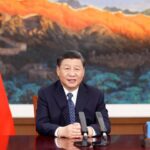Chinese space analysts said their optimism for the success of Tianzhou-2 mission has not been frustrated by the delay of launch, which the China Manned Space Agency (CMSA) announced around 1 am on Thursday, the original planned window, as they strongly speculated that ideal launch window will once again show up next week, and such a brief delay of Tianzhou-2 won’t affect the space station’s construction schedule.
Mounted on a Long March-7 Y3 carrier rocket, the Tianzhou-2 cargo spacecraft was tasked with rendezvousing and docking with the Tianhe core module cabin for the first supply run for China’s space station. However, the launch was scrubbed narrowly following an announcement from CMSA on early Thursday morning for “technical reasons,” with the new time for launch “yet to be determined.”
The announcement soon drew widespread attention from millions of stargazers from home and abroad, who sent heartfelt messages to cheer up those involved in the mission, while expressing faith in China’s aerospace capability. Many are also wondering when would the “delivery guy” of China’s space station be ready for its next liftoff.
Chinese space analysts reached by the Global Times said that compared to deep space exploration missions, the renewal period for launch windows of the Tianzhou-2 to low Earth orbit where the Tianhe core cabin awaits, is considerably shorter, and it is likely that Tianzhou-2 will be launched during an ideal window sometime next week.
Several factors determine the launch window for space missions, namely the weather conditions, technical status of the spacecraft, and the relative position from the launch site to planned destination or target object in space, which in this case is the Tianhe core cabin, Wang Ya’nan, chief editor of Aerospace Knowledge magazine, explained to the Global Times on Friday.
Observers believed that the frequent launch window has allowed Tianzhou-2 to be set for the mission in the shortest time possible, and it will unlikely have a major impact on the set timetable of China’s space station construction project.
Next, Shenzhou-12 crewed spacecraft is scheduled for launch via the Long March-2F carrier rocket in June, sending three astronauts into orbit for about three months, during which the regenerative life support system and maintenance will be tested.
Even if it is going to be a week-long delay, it will only demand a new orbit calculation [for the launch of Shenzhou-12], but it will not lead to a major impact, Song Zhongping, a space analyst and TV commentator, told the Global Times on Friday.
Echoing Song, another space analyst who asked not to be named explained that that as the June mission will be carried out in a different launch center, via a different launch vehicle, the Shenzhou-12 crewed mission will be hardly affected by the Tianzhou-2 supply mission.
An intense schedule of 11 launches has been set for the construction of China’s space station, which started on April 29 with the launch of Tianhe core cabin and will continue through 2022. China’s space station is expected to become operational by around 2022.
Wang believed that mission designers had left room for window adjustment between missions in the first place, so that such delay of one single mission would hardly affect the two years’ schedule.
Chinese space authorities have not specified the “technical reasons” that led to the delay as of press time.
Wang said it indicates that scientists would conduct extremely thorough examinations to all components related to the system, including the carrier rocket, the cargo spacecraft, and hardware of the launch port, before they announce a conclusion.
“Research teams will not allow even one tiny abnormality, and if they found one, they will spare no efforts to detect, troubleshoot, and repair it,” Wang said.
Space insiders revealed that since the Long March 7 carrier rocket was fueled by new clean energy, liquid oxygen and kerosene, which must be stored in low temperatures, the propellants need to be removed if maintenance takes a few days. The pre-launch system examinations and fuel injection for the next launch will take only a few hours, they said.
The decision of delay has also showed that China is not rushing into anything but keeping a steady pace, and is calm and confident in preventing any potential risks from happening, observers noted.
In a similar previous case on June 16, 2020, China delayed the launch of the final satellite of the BeiDou-3 satellite navigation system after a technical problem was found during a test ahead of launch. In less than two days, the problem was properly solved with all systems verified as normal.
The final satellite of the BeiDou-3 satellite navigation system was successfully sent into space and entered its planned orbit on June 23, 2020.
Photo: Courtesy of CALT



